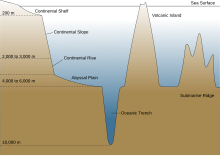Deep sea level
This article was due to content flaws on the quality assurance side of Geosciences portal entered. This is done to increase the quality of the articles in the geosciences topic. Please help to correct the deficiencies or take part in the discussion . ( + )
Reason: Unskilled translation, apparently based exclusively on the Encyclopedia Britannica article - Gretarsson ( discussion ) 15:15, 23 Jan. 2019 (CET)
The deep sea level (also abyssal level ) is a flat seabed area that is 3000 to 6000 m below sea level and usually borders on a continent . The height difference of these underwater areas is only 10 to 100 cm over a distance of one kilometer.
Occurrence
Deep sea plains usually have an irregular profile and run along the continental margins , the larger plains are hundreds of kilometers wide and several thousand kilometers long. The Sohm Plain in the North Atlantic alone has an area of approx. 900,000 square kilometers. The plains are largest and most common in the Atlantic , less common in the Indian Ocean and even rarer in the Pacific , where they occur mainly as the small, flat bottoms of marginal seas or as narrow, elongated bottoms of deep-sea trenches .
Origin and composition
The plains are probably the surfaces of terrigenous sediments that have accumulated in the deep sea depressions and thus smoothed an already existing hilly or otherwise irregular terrain structure. Seismic profiles (cross-sections) of deep-sea plains show sediment accumulations with an average thickness of one kilometer, which have been deposited on an undulating topography. Incomplete spillage of already existing reliefs can lead to isolated volcanic mounds or groups of mounds that rise abruptly from some plains. Deposits from the continental margins tend to accumulate on the steep continental slopes, and the occasional sinking of this coarse material to the sea floor creates dense, sediment-rich slurries, called turbid currents , which flow down the slopes according to the law of gravity . Some of the turbid sediment settles at the feet of the continental slopes and creates continental elevations with less gradients, but some of the coarse sediment also reaches the deep sea depressions. Muddy, sandy and even gravelly horizontal layers, which can be a few millimeters to several meters thick, make up two to 90 percent of the sediment of the deep sea level. Many of these layers have been shown to consist of shallow water organisms , e.g. B. the microscopic protozoan foraminifera . The fineness of the grain can increase from bottom to top for a single layer; in this case the grain size distribution reflects the deposition of a single turbidity stream.
The coarse layers are interspersed with homogeneous deposits of fine-grain clay and the microscopic remains of organisms that live in the seas above the deep sea levels. Presumably, these fine-grained sediments fall through the columns of water in particles between the turbidity current phases and collect at an extremely slow rate (one millimeter to several centimeters per 1000 years). An alternative hypothesis suggests that deep-sea clay deposits were continuously transported by slowly flowing, diffuse turbid groundwater that originated in turbulent, shallow coastal areas.
See also
Individual evidence
- ↑ a b c d Abyssal plain. In: Encyclopædia Britannica . Retrieved January 23, 2019 .
